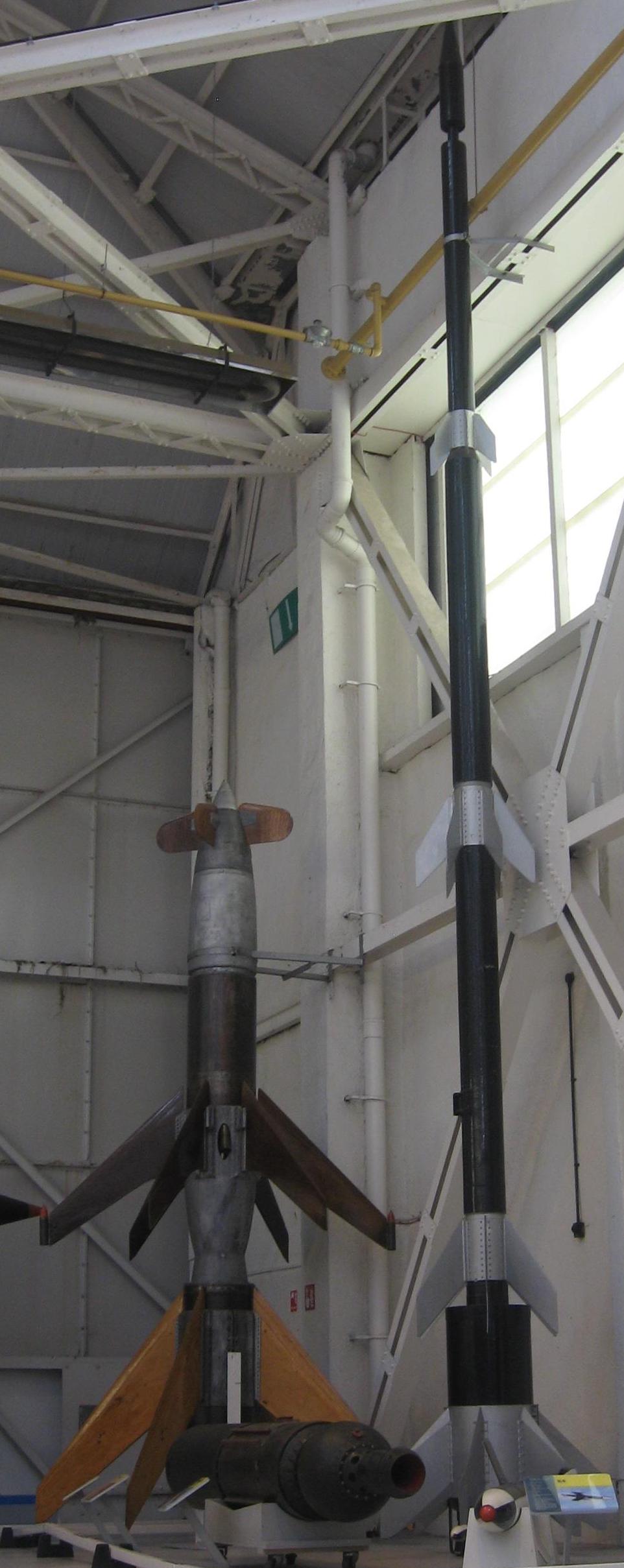Rheintochter on:
[Wikipedia]
[Google]
[Amazon]
''Rheintochter'' was a German
 The initial R1 variant was powered by a two-stage
The initial R1 variant was powered by a two-stage
Smithsonian National Air and Space Museum
Royal Air Force Museum, Cosford (UK)
World War II guided missiles of Germany Surface-to-air missiles of Germany
surface-to-air missile
A surface-to-air missile (SAM), also known as a ground-to-air missile (GTAM) or surface-to-air guided weapon (SAGW), is a missile designed to be launched from the ground or the sea to destroy aircraft or other missiles. It is one type of anti-ai ...
developed by Rheinmetall-Borsig
Rheinmetall AG () is a German automotive and arms manufacturer, headquartered in Düsseldorf, Germany. The group was promoted to the DAX, Germany's leading stock market index, in March 2023. It is the largest German and fifth largest Europe ...
during World War II
World War II or the Second World War (1 September 1939 – 2 September 1945) was a World war, global conflict between two coalitions: the Allies of World War II, Allies and the Axis powers. World War II by country, Nearly all of the wo ...
. Its name comes from the mythical ''Rheintöchter'' (Rhinemaidens
The Rhinemaidens are the three Nixie (water spirit), water-nymphs (''Rheintöchter'' or "Rhine daughters") who appear in Richard Wagner's opera cycle ''Der Ring des Nibelungen''. Their individual names are Woglinde, Wellgunde and Flosshilde (Flo� ...
) of Richard Wagner
Wilhelm Richard Wagner ( ; ; 22 May 181313 February 1883) was a German composer, theatre director, essayist, and conductor who is chiefly known for his operas (or, as some of his mature works were later known, "music dramas"). Unlike most o ...
's opera series ''Der Ring des Nibelungen
(''The Ring of the Nibelung''), WWV 86, is a cycle of four German-language epic music dramas composed by Richard Wagner. The works are based loosely on characters from Germanic heroic legend, namely Norse legendary sagas and the . The compo ...
''.
The missile was a multi-stage solid fuel
Solid fuel refers to various forms of solid material that can be burnt to release energy, providing heat and light through the process of combustion. Solid fuels can be contrasted with liquid fuels and gaseous fuels. Common examples of solid fu ...
led rocket.Christopher, p.131. It had four small varnished plywood control surfaces, resembling paddles, in the nose, six fins at the after end of the top stage, and four at the end of the main stage. It stood tall, with a diameter of . The sustainer motor, located ahead of the warhead (rather than behind, as is more usual) exhausted through six venturis between the first stage fins.
History
''Rheintochter'' was ordered in November 1942 by the German army ( ''Heer''). Starting in August 1943, 82 test firings were made. An air-launched version was also designed. The operational version was intended to be fired from a ramp or converted gun mount. The project was cancelled on 6 February 1945. Examples are on display at the Steven F. Udvar-Hazy Center inChantilly, Virginia
Chantilly is a census-designated place (CDP) in western Fairfax County, Virginia, United States. The population was 24,301 as of the 2020 census. Chantilly is named after an early-19th-century mansion and farm, which in turn took the name of an ...
, the ''Deutsches Museum
The Deutsches Museum (''German Museum'', officially (English: ''German Museum of Masterpieces of Science and Technology'')) in Munich, Germany, is the world's largest museum of science museum, science and technology museum, technology, with a ...
'' in Munich
Munich is the capital and most populous city of Bavaria, Germany. As of 30 November 2024, its population was 1,604,384, making it the third-largest city in Germany after Berlin and Hamburg. Munich is the largest city in Germany that is no ...
, Air Defense Learning Annex at Fort Sill, OK and at the Royal Air Force Museum Midlands, UK.
Variants
 The initial R1 variant was powered by a two-stage
The initial R1 variant was powered by a two-stage solid-fuel rocket
A solid-propellant rocket or solid rocket is a rocket with a rocket engine that uses Rocket propellant#Solid chemical propellants, solid propellants (fuel/oxidizer). The earliest rockets were solid-fuel rockets powered by gunpowder. The incepti ...
.
The proposed R2 did not offer any improvement over the R1, and was dropped in December 1944.
The R3 model was developed, which had a liquid fuel engine with solid-fuel boosters ("strap-ons"). Only six trial missiles were fired.
Specifications
* Power plant: RI variant was 2-stage solid fuel; RIII was liquid fuel with solid-fuel boosters * Length: Ford, Brian J., ''Secret Weapons'', Osprey Publishing, 2011, p.80, * Diameter: Ford, p.80 * Wing span: * Launch weight: * Speed: 1,080 km/h (671 mph) * Warhead: * Altitude: R1 8 km * Guidance system: Radio CommandSee also
* List of World War II guided missiles of Germany * EnzianNotes
Sources
* Christopher, John. ''The Race for Hitler's X-Planes''. The Mill, Gloucestershire: History Press, 2013. * Ford, Brian J., ''Secret Weapons'', Osprey Publishing, 2011,External links
{{Commons category, RheintochterSmithsonian National Air and Space Museum
Royal Air Force Museum, Cosford (UK)
World War II guided missiles of Germany Surface-to-air missiles of Germany